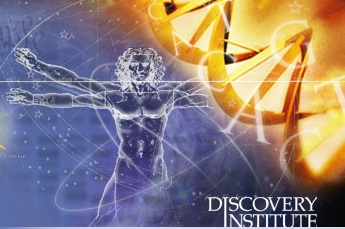This is a two-part series by Logan Paul Gage, of the Discovery Institute, about Intelligent Design. We posted part one last week — this is part two, and today’s post covers two themes: God and beauty.
Intelligent design and the deity
 In the predominant
In the predominant
narrative, Charles Darwin was a humble scientist who proposed a
strictly scientific theory. Upon publication of The Origin of Species
in 1859, religious folks like Bishop Wilberforce voiced theological
objections to it; and thus began the most salient episode in the ‘war
between science and religion.’ Many Christians adopt a similar
narrative, but suggest this was all a misunderstanding; Darwin’s theory
simply has nothing to do with religious or philosophical questions.
If
I may be so bold, I’d like to suggest that both narratives are wrong.
(For a good, short critique of the “conflict thesis” of science and
religion, see God’s Undertaker by Oxford’s John Lennox.) If one reads
The Origin, the fact that Darwin is presupposing certain views of God
and creation fashionable in Victorian England is striking. This theory
involved more than strictly scientific questions from the beginning.
One
such theological conception common in this debate (touched upon by RJS
in a recent post) involves whether God is a “tinkerer.” Kenneth
Miller, Catholic Darwinist of Brown University, sums up this view
well. He thinks that neo-Darwinism’s view of God is better than ID’s:
“The
God of the intelligent design movement is way too small…. In their
view, he designed everything in the world and yet he repeatedly
intervenes and violates the laws of his own creation. Their God is
like a kid who is not a very good mechanic and has to keep lifting the
hood and tinkering with the engine.”
As C.S. Lewis was fond of
pointing out, divine action does not require the breaking of laws of
nature. So let’s set that aside and make two other observations.
First,
if ID is only the proposition that an intelligent cause explains some
features of nature better than mere material causes, then the ID
advocate is not necessarily committed to intervention in the process of
creation. God could (intelligently) set up nature to unfold a certain
way. He need not intervene in “gaps.” All ID requires is that
intelligent design was involved and that the effects of this design are
empirically discernable.
Michael Behe, for example, thinks there
were probably not any interventions by God in creation. Other ID
theorists think otherwise.
Second, and more to our point, as
post-modern philosophers of science often point out, even the questions
we ask are from a certain frame of reference. Miller seems to ask,
‘Why would God create a world which he has to tinker with?’ But
wouldn’t it be equally valid to ask, ‘Why would God design a process in
which he isn’t going to be involved?’
Is “tinkering” really the
only way to look at it? Tinkering is a rather loaded term. Did Monet
“tinker” or did he add detail, richness, and complexity? Would Monet
have been a better artist if instead of tinkering with paintings he
created a machine which relied upon a random number generator to
manufacture them without his involvement? It might have saved him some
work, but it wouldn’t have let him be an artist. (And one supposes God
isn’t too concerned with saving work.)
St. Thomas often relied
upon the principle that effects cannot be greater than their causes.
In this regard, wouldn’t it be odd if the creator of artists should not
also be an artist?
The origin of beauty
This is the third in a series of three posts, Intelligent Design and the Artist’s Soul.
Benjamin
Wiker and Jonathan Witt’s masterful book A Meaningful World: How the
Arts and Sciences Reveal the Genius of Nature gives the following
illustration of how modern scientific reductionists treat nature and
the arts:
Imagine hearing the following
account of one of Wolfgang Amadeus Mozart’s symphonies: ‘We have been
able to prove that this particular symphony is actually reducible to a
series of notes that happen to be played both at the same time in
chords and one after another, creating a string of disturbances in the
air caused by different frequencies. We realize, of course, that these
disturbances cause further disturbances in the audience, due in part to
the presence of Earth’s particular atmosphere and in part to the effect
such disturbances have on the apparatus of the ear as transmitted by
neurons to the brain–so disturbing, in fact, that some break into
voluntary tears, remarking that they seemed to be hearing the very
harmonies of heaven. Happily, we now know that there is nothing more
to Mozart’s work in particular and to music in general than mere notes,
themselves reducible to waves disturbing air.’
When
Christian intellectuals hear such things, their general response is to
think that they can have their Darwinian cake and merely scrape off the
reductionist icing. But Darwinism, if I may continue the strained
metaphor, is, it turns out, a layered cake with icing all throughout.
Continue Wiker and Witt:
“Such
reductionism displays the kind of bluntness of soul we found in Sigmund
Freud, which could reduce the glory of Hamlet to the irrational
gurglings of sexual desire. It is the precise bluntness of soul that
led Charles Darwin to reduce the origin of music to mating calls and,
hence, to the sexual desire that drives sexual selection.”
The
authors refer here, of course, to Darwin’s reductionist account of
music in The Descent of Man and Selection in Relation to Sex. Many
Christians think science determines the ‘how’ and religion determines
the ‘why.’ But we see here that in the strange case of Darwinism, this
simply won’t do. Natural selection swallows up other causal chains.
The ‘why’ of natural phenomena reduces to ‘because it enhanced
reproductive success.’ And beauty–to the artist’s great horror–is no
exception.
As University of Chicago biologist Jerry Coyne
writes, “any injection of teleology into evolutionary biology violates
precisely the great advance of Darwin’s theory: to explain the
appearance of design by a purely materialistic process–no deity
required.”
In chapter six of The Origin, Darwin further destroys
the beauty of beauty, demoting it to an illusion which, once again,
enhances reproductive fitness. Darwin there writes that if his theory
is truth, nothing in nature was created for the beauty of man. Nor is
beauty of any real substance, but completely arbitrary.
The
Darwinian, at least in his philosophical commitments, is tone deaf. As
A.N. Wilson (the great biographer of C.S. Lewis) recently wrote of
philosophical materialists in explanation of his re-conversion to
Christianity, “they seem to me like people who have no ear for music,
or who have never been in love. It is not that (as they believe) they
have rumbled the tremendous fraud of religion–prophets do that in
every generation. Rather, these unbelievers are simply missing out on
something that is not difficult to grasp. Perhaps it is too obvious to
understand; obvious, as lovers feel it was obvious that they should
have come together, or obvious as the final resolution of a fugue.”
Nature’s
design is just like this. Too obvious to grasp. (As Lewis said, fish
don’t feel wet.) But this is why we need the artist. For the artist
senses the transcendent and eternal in the mundane and temporal. She
makes plain what should be plain; stirs in us what is simmering
unconsciously. Conveys the immaterial through the material.
So
why have so many of the best artists of our generation, even rather
secular ones–the Kurt Vonnegut, Jr.s, the Tom Wolfes, etc.–been
unable to shake their skepticism of Darwinian fairytales? Because
Darwin’s view strikes at the heart of the artist’s soul, reducing all
purposes, all agency actually, to survival. The Darwinian world is no
longer a shadowland, for it is without Sun. To the artist, however,
such reductionism will ever echo falsely in the quiet hour, when
another world whispers.


